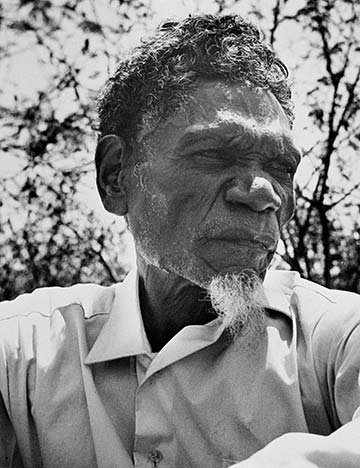MAWALAN MARIKA
BIOGRAPHY

Image: National Museum of Australia
Mawalan Marika, head of the Rirratjingu clan, from North East Arhnem land, is considered one of the true ‘greats’ of the bark tradition. Born into an era before intensive European c olonisation, he became a principle informant to anthropologists Charles Mountford, Roland Berndt and Catherine Berndt in the production of much of the early literature on Arnhem Land song poetry. He was one of the first painters commissioned by the missionary Wilbur Chaseling, and produced artworks for Dr.Stuart Scougall and Tony Tuckson at the Art Gallery of New South Wales in Sydney in the late 1950’s. Yet his life and work testify to an ambiguous relationship with the colonial presence. He was amongst the ringleaders in the fight for Aboriginal land rights in the 1960’s and 1970’s playing an instrumental role in the production of the ‘Bark Petition’ to the Commonwealth Parliament, used most effectively as testament to their claim over their land and consequent right to negotiate the terms of mining on it. He also made a very personal political statement in introducing women to painting on bark in the 1960’s when he taught his two oldest daughters to paint their family designs, though they were not embraced by the Australian art market until later decades (Johnson: 1995).
Mawalan’s paintings, while characteristic of barks emanating from Yirrkala from the 1960’s to 1980’s in their narrative mode of representing myth, are specifically revered for their conceptual grandeur. The Seagull 1962 is characteristic of his style in using symbolic figurative imagery grouped into compositions surrounded by formal designs associated with the Rirratjingu. In keeping with other Anthem land art of the period, meaning is developed through intricate symbolism which accommodates both a secular and deeper, spiritual dimension. (Knight: 1991, p26). Malawan was very committed, convinced with other spiritual leaders who also painted large collaborative works of the most sacred stories at the time, that their most important sites were under threat from bauxite mining (Neale: 1994). Another ethnographic theme in his work was the depiction of the relations between Maccasan traders and Aboriginal people of Arnhem Land as early as the 17th Century.
Due to his historical and artistic prominence Mawalan is one of the most revered and widely represented artists in galleries and museums in Australia and overseas. His work still forms the centrepiece of the Art Gallery of NSW Indigenous collection and he is the subject of considerable literature, including a documentary film In memory of Mawalan 1981.
© Adrian Newstead
References
Dunlop, I. 1983 In memory of Mawalan [videorecording], Publisher Lindfield, N.S.W. : Film Australia.
Johnson, Vivien., 1995, 'Is there a gender issue in Aboriginal art?', Art & Australia, Vol. 32, No. 3, pp. 350-357.
Knight, A. 1991, Aboriginal Art and Spirituality, Crumlin, R., (ed.), Collins Dove, North Blackburn, Victoria.
Neale, M., 1994, Yiribana, exhib. cat., Art Gallery of New South Wales, Sydney.

